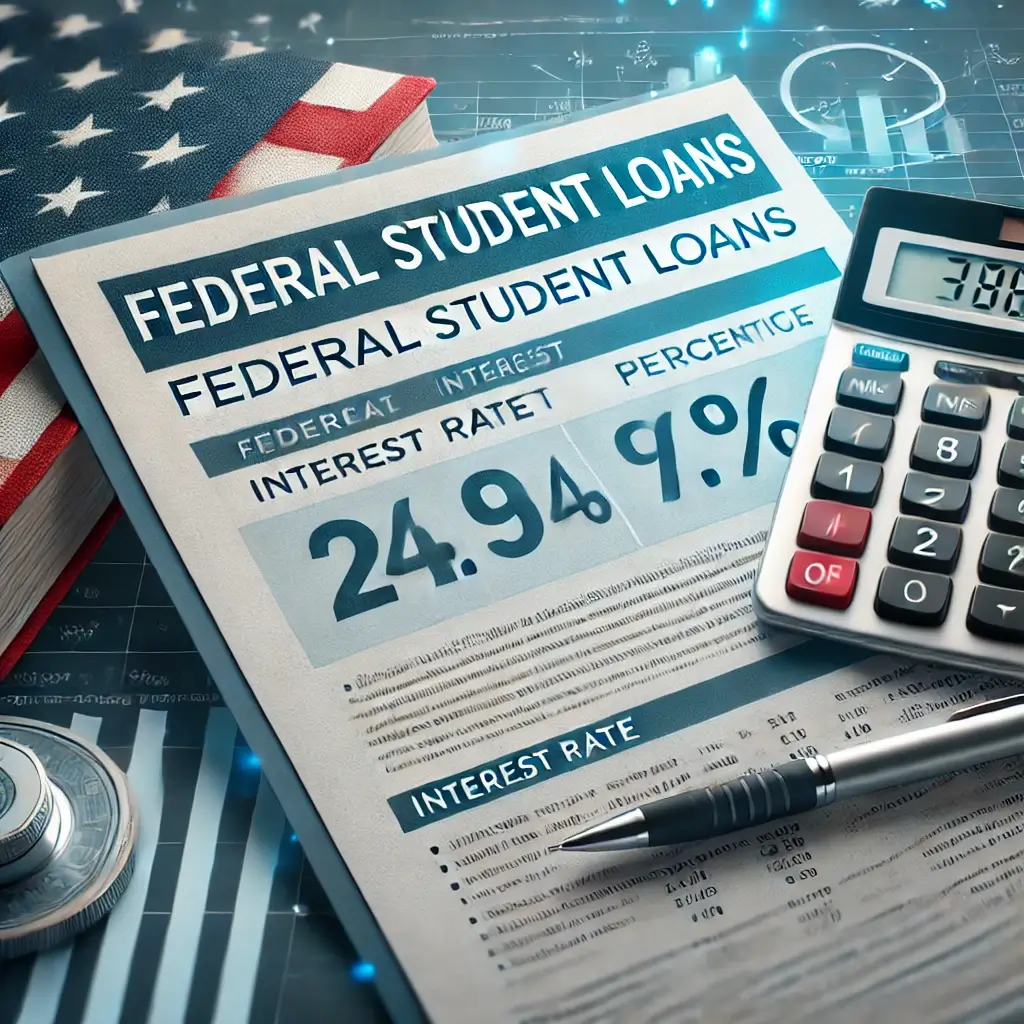Understanding Interest Rates for Federal Student Loans is crucial for students and families looking to finance education affordably. Federal loans offer lower, fixed interest rates compared to private loans, making them a popular choice. In this guide, we’ll explore current Interest Rates for Federal Student Loans, how they work, and how they impact repayment.
1. Types of Federal Student Loans and Their Interest Rates
Federal student loans come in several forms, each with an interest rate. Here’s a breakdown of the Interest Rates for Federal Student Loans by type:
1.1 Direct Subsidized Loans – Affordable for Undergraduate Students
- Eligibility: Undergraduate students with demonstrated financial need.
- Interest Rate: Fixed rate set annually by Congress, currently at 5.05%.
- Interest Benefits: The government covers the interest while in school, during grace periods, and deferment.
Direct Subsidized Loans offer some of the Best Interest Rates for Federal Student Loans, as they’re aimed at making education more accessible for students with financial need.
1.2 Direct Unsubsidized Loans – Accessible for All Students
- Eligibility: Available to both undergraduate and graduate students without the need to demonstrate financial need.
- Interest Rate: Fixed rate, currently 5.05% for undergraduates and 6.6% for graduate students.
For students who may not qualify for need-based aid, Direct Unsubsidized Loans provide competitive Interest Rates for Federal Student Loans, although interest starts accruing immediately.
1.3 Direct PLUS Loans – Bridging the Funding Gap
- Eligibility: Parents of dependent undergraduates, and graduate/professional students.
- Interest Rate: Fixed rate, currently at 7.6%, with a credit check required.
Though slightly higher, the Interest Rates for Federal Student Loans on PLUS loans allow families to cover the total cost of education, minus any other financial aid.
1.4 Direct Consolidation Loans – Simplifying Loan Repayment
- Purpose: Combine multiple federal loans into one, often extending the repayment period.
- Interest Rate: Weighted average of all consolidated loans, rounded up to the nearest 1/8th percent.
Direct Consolidation Loans can simplify repayment but may result in a higher interest rate. When considering these Interest Rates for Federal Student Loans, borrowers should weigh the convenience of consolidation against potential interest costs.
2. How Federal Student Loan Interest Rates Are Determined
Federal student loan interest rates are set annually by Congress and based on the U.S. Treasury’s 10-year note, plus an additional fixed margin. These rates are fixed for the life of the loan, providing stability for borrowers. Here’s how the process works:
- Annual Adjustment: Each year in May, Congress sets the interest rates for new federal student loans.
- Fixed Rate Benefits: The rate remains the same for the loan’s duration, allowing predictable monthly payments.
- Treasury Rate Impact: Rates fluctuate based on economic conditions and the current Treasury rate.
By understanding this process, borrowers can better anticipate the Interest Rates for Federal Student Loans they’ll face when applying for new loans.

3. Why Federal Student Loan Interest Rates Are Beneficial
Federal student loans generally offer more favorable terms than private loans. Here are some of the primary benefits of Interest Rates for Federal Student Loans:
3.1 Lower Rates Compared to Private Loans
Most private loans come with variable rates that can rise over time. Federal student loans, however, offer low fixed interest rates set by the government. This fixed nature provides stability and often results in lower monthly payments compared to variable-rate private loans.
3.2 Fixed Rates for Predictable Monthly Payments
The Interest Rates for Federal Student Loans are fixed, so monthly payments remain consistent, which helps with financial planning. Borrowers can calculate their total repayment amount upfront and avoid surprises.
3.3 Access to Income-Driven Repayment Plans
Federal loans allow borrowers to choose from various income-driven repayment plans. With these plans, monthly payments are based on income, making them manageable regardless of the Interest Rates for Federal Student Loans.
3.4 Options for Loan Forgiveness Programs
Federal loans come with access to forgiveness programs like Public Service Loan Forgiveness (PSLF), which can alleviate the burden of higher interest rates over time. This means that even if Interest Rates for Federal Student Loans seem high, they can still offer significant benefits.
4. Calculating Interest Costs for Federal Student Loans
To understand how Interest Rates for Federal Student Loans affect your total cost, it’s essential to know how interest is calculated. Federal loans use simple interest, meaning interest accrues daily based on the principal balance.
4.1 Simple Daily Interest Calculation
The daily interest rate is determined by dividing the annual interest rate by the number of days in a year (365). For example

4.2 Example Calculation
Let’s say you have a $10,000 Direct Unsubsidized Loan with a 6.6% interest rate:
- Daily Interest: 0.066/365×10,000=Approximately $1.81
- Monthly Accrual: About $54.30 in interest per month.
Using this example, you can see how Interest Rates for Federal Student Loans directly impact the monthly cost of borrowing. By paying attention to these rates, students can budget more effectively for their education.
5. How to Lower Interest Costs on Federal Student Loans
While you can’t change the Interest Rates for Federal Student Loans, there are strategies to reduce the total interest paid over time:
5.1 Pay While in School or During Grace Periods
Making payments on unsubsidized loans while still in school can prevent interest from capitalizing, which ultimately reduces total costs.
5.2 Pay More Than the Minimum Payment
If possible, make extra payments on your loan. By reducing the principal faster, you lower the overall amount on which interest is calculated.
5.3 Choose an Income-Driven Repayment Plan Wisely
Income-driven plans can help make payments manageable, but extending the repayment term may result in more interest over time. Select a plan that balances affordability with minimizing interest costs.
6. Frequently Asked Questions About Interest Rates for Federal Student Loans
6.1 Do Federal Student Loan Rates Change Annually?
Yes, new federal loan rates are set each year based on the U.S. Treasury’s 10-year note, plus a fixed margin. Existing loans keep the rate set at the time of disbursement.
6.2 Can I Refinance Federal Student Loans to Lower My Rate?
While federal loans cannot be refinanced within the federal system, borrowers can refinance with private lenders. However, this may mean losing federal benefits such as income-driven repayment plans and loan forgiveness options.
6.3 What Happens If I Default on a Federal Student Loan?
Defaulting on a federal student loan can lead to significant penalties, including additional fees, wage garnishment, and damage to your credit score. Reach out to your loan servicer to explore repayment options if you’re struggling to make payments.
Conclusion on Interest Rates for Federal Student Loans
Understanding Interest Rates for Federal Student Loans is vital for students and families planning to finance higher education. With lower rates, fixed payments, and various repayment options, federal loans offer flexibility and security that make them a preferred choice. By knowing how interest works and planning strategically, borrowers can manage their loans effectively and minimize costs over time.
